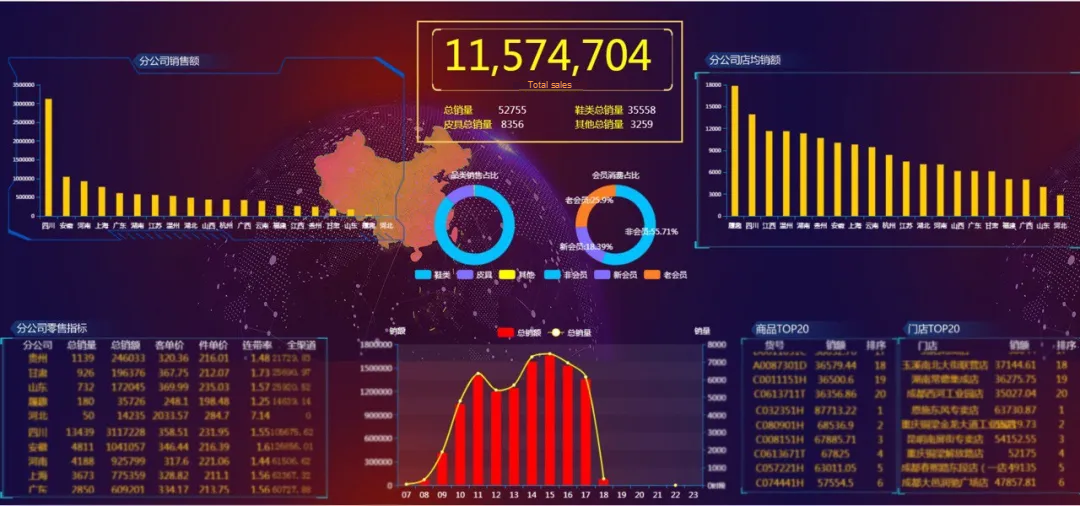The Alibaba Cloud 2021 Double 11 Cloud Services Sale is live now! For a limited time only you can turbocharge your cloud journey with core Alibaba Cloud products available from just $1, while you can win up to $1,111 in cash plus $1,111 in Alibaba Cloud credits in the Number Guessing Contest.
By Wang Ziwei from onRetailing
Red Dragonfly is a leading and listed shoes and clothing company founded in 1995. Recently, amid the COVID-19 outbreak, Red Dragonfly was able to achieve a sales volume of RMB 1 million despite suspending 4,000 stores amid the COVID-19 outbreak. By focusing on digitization and intelligentization, Red Dragonfly created 500 groups to cover 120,000 customers served by a marketing team comprising all its 5,000 employees.
Having faced the severe acute respiratory syndrome coronavirus (SARS-CoV) epidemic in 2003, Red Dragonfly still has a deep institutional memory of the impact of the epidemic.
"At that time, we couldn't do anything but wait for everything to get better," Qian Jinbo, chairman of Red Dragonfly, said. "No digital concepts or tools existed then. Even the best customer relationship management (CRM) systems could only be used to send short messages and small gifts to customers."
Back in 2003, digitization was still only a hazy concept. However, by 2020 Red Dragonfly was already prepared for digitization because of its cooperation in 2018 with Alibaba Cloud to launch digitization and "intelligentization".
"I brought my team to Alibaba and we talked with Alibaba Cloud's new retail team, which was headed by Xiao Bo, for a long time, on a variety of issues such as what new retail is, the value of new retail, and its development direction. In the end, we made up our minds to start the process of digitization and intelligentization," said Qian Fan, vice chairman of Red Dragonfly.

Qian Fan leads a team to visit Alibaba Cloud's new retail team headed by Xiao Bo
The introduction of new tools was the first step for Red Dragonfly to launch digitization and intelligentization.
In 2018, a variety of tools enabled Red Dragonfly to directly reach customers online. Customers at any Red Dragonfly stores could join the membership program by scanning the DingTalk QR code of an in-store sales consultant through the Taobao Mobile app, and could be bound to this sales consultant.
This program brought at least three benefits. First, the customer's online and offline purchases could be included in the sales consultant's performance metrics, greatly increasing the consultant's enthusiasm for work. Second, the customer's contact information could be recorded by the sales consultant and the company, which prevents potential customer loss in the case of resignation by the sales consultant. Third, when communicating with the customer by phone, the sales consultant could record the customer's preferences, which could be stored as tags in the company's backend system, giving the company more information about the characteristics of the customer.
Red Dragonfly combines DingTalk and Taobao Mobile to implement a closed-loop process that spans attracting, reaching, and retaining customers, to converting new customers into returning customers. Data shows that in 2018 Red Dragonfly attracted 1.6 million consumers to more than 1,000 self-operated and jointly operated stores.
These digital and intelligent tools helped Red Dragonfly keep its business afloat during the coronavirus disease (COVID-19) outbreak in 2020.
Business was suspended at Red Dragonfly's more than 4,000 stores due to the COVID-19 epidemic. At an emergency meeting held on February 1, the headquarters of Red Dragonfly decided to fully launch its services and marketing online. Within just 7 days, Red Dragonfly employees established more than 500 groups to cover hundreds of thousands of customers, bringing a daily sales volume of more than 1 million.
Each employee assumed the role of a sales consultant, no matter their previous experience in sales. An accountant at the headquarters struck dozens of deals by giving away rice as a free gift with purchase to shoe buyers.
During the COVID-19 epidemic, Red Dragonfly taught their frontline employees how to improve their efficiency and serve customers through online training and live streaming at Taobao University and Alibaba Cloud's new retail growth camp. This helped every employee master the basic skills of establishing private domain traffic and serving customers, and also greatly enhanced Red Dragonfly's online marketing capabilities. The COVID-19 outbreak accelerated the process of digitization and intelligentization at Red Dragonfly.
"Some sales consultants used to be resistant to online marketing. The COVID-19 outbreak led to business suspension at stores and forced everyone to go online. This accelerated our digitization and intelligentization process," Qian Fan said.

Alibaba New Retail
In the meantime, all directives were sent to every employee through DingTalk, rather than by issuing official documents through multiple links. Frontline employees could quickly obtain the latest announcements and immediately adjust their marketing direction. DingTalk helped Red Dragonfly to evolve from a traditional company into an agile organization.
A crisis always brings opportunities. Qian Jinbo explained the impact of this crisis on Red Dragonfly through a metaphor: "We are used to eating with chopsticks held in our right hand. When my right hand is hurt, fortunately my left hand has prepared to take over and soon I will be able to eat with chopsticks held in my left hand. When my right hand is recovered, I will be able to eat with chopsticks held in either hand as needed."
Red Dragonfly digitized its stores while introducing tools through digitization.
The data collected from the Internet of Things (IoT) and other hardware reflects not only the sales volume but also consumer behaviors. "Hardware devices such as IoT help us to know the flow of customers and the heat zones of each store," Qian Fan said frankly. "When the sales in a region drop, we will immediately instruct the store to find the reason, adjust products, and change its strategy."

An in-store display at a Red Dragonfly store
During the Double 11 Shopping Festival in 2019, Red Dragonfly held a 4-day offline shopping festival themed "Let's Go Have Fun!" The real-time sales data of each store is displayed on a dashboard at the Red Dragonfly headquarters. "When the sales data falls short of our expectation, we will immediately communicate with the specific store and help the store staff to reach out to members and customers by using technologies and systems, to bring them to the store," Red Dragonfly's new retail director Yu Aifei said.
Real-time data is the primary benefit of store digitization, which enables Red Dragonfly to obtain a digital understanding of its products.
Terminals and technical capabilities such as IoT help Red Dragonfly clearly understand every consumer behavior, such as picking up and trying on a pair of shoes. Imagine that a store has two different pairs of shoes that are not selling well. One pair of shoes is hardly ever tried on by customers, whereas the other pair is tried on many times a day. The reasons for the poor sales of these two pairs of shoes are different. The company can analyze the reasons in terms of process, price, and quality based on data rather than personal experience or speculation.

A 4-day offline shopping festival themed "Let's Go Have Fun!" at a Red Dragonfly store
Then, the system sends data-rich feedback to the operations, planning, R&D, and production departments to help them comprehensively optimize and adjust the sales approach. For products that sell well, the company can use this data to encourage customers to increase or repeat orders. For products that do not sell well, the company can stop restocking, and promptly follow up with operational changes. Any problems can be solved after adjustments are made.
"Digital stores can not only analyze sales data, but also gain insight, through scientific and technological means, into how to optimize the products, display, flow of customers, and sales conversion in a timely manner. This is how digitization and intelligentization have changed our thinking and operations," Qian Fan said.
Every day, nearly 10 million consumers are served by sales consultants online and at digitized stores. This creates massive amounts of data. However, having data is meaningless if we don't know what to do with the data.
Putting data online is the first step of digitization. Digitization and intelligentization are intended to rebuild enterprises by digital means, to enable them to locate and solve problems whenever they are discovered.
"Alibaba is an example of successful digitization, with support for external export, and the capability to help merchants. This is why we fully embraced Alibaba," Qian Fan said. "Alibaba has a complete set of solutions to help us attain the level of digitization that it has achieved itself."
Red Dragonfly first developed a comprehensive marketing plan and formulated a transformation program that encompassed the membership program, products, stores, and marketing. The data mid-end was essential for implementing the transformation program.
A traditional company tends to keep a wealth of data that is collected from multiple channels. Every store or sales consultant may be an information silo. To sort discrete data, the company needs to interconnect its enterprise resource planning (ERP), CRM, and supply chain management (SCM) systems based on business planning.

Red Dragonfly's sales dashboard
Interconnecting this data creates an "information center" that a company can use to know its status quo and locate and solve problems. Some applications have reaped benefits for Red Dragonfly, which achieved an omni-channel sales volume of RMB 380 million during the Double 12 Shopping Festival in 2019.
Qian Jinbo made an interesting comment, "We might have all kinds of tools, but lack critical information. Without data or information, we cannot reach our goals. Once we have the desired information, we can solve problems effortlessly."
Digitization and the data mid-end have brought great changes to the backend of Red Dragonfly.
"In the beginning, our data was coarse-grained. We only knew the sales data on general categories such as business shoes and fashion shoes. It was difficult to develop subcategories," Qian Jinbo said.
Taking sales territories as an example, digitization enabled Red Dragonfly to segment data into specific cities and stores in real time. This real-time and accurate segmentation gives insight into localized product demand. For example, the shoe size and shoe shape vary between customers in Northeast China and those in Zhejiang province.

This "little data" from stores and products, combined with Red Dragonfly's consumer profiles, can provide guidance on R&D and design adjustment in the backend, as well as guidance on fast and flexible production and replenishment by original equipment manufacturers (OEMs). For example, the general category of business shoes can be divided into subcategories, such as business travel, socializing, and business routine. This allows Red Dragonfly to provide suitable products for business people with specific needs.
In this regard, Qian Jinbo concluded that Red Dragonfly used to rely on experience to make judgments but now has big data to guide production through analysis and predictions. Digitization and intelligentization allow Red Dragonfly to carry out customer-to-manufacturer (C2M) production.
In Red Dragonfly, chairman Qian Jinbo is mainly responsible for partial backend businesses such as products and the supply chain, whereas vice chairman Qian Fan, son of Qian Jinbo, is responsible for marketing, branding, and digitization and intelligentization.
"He was born in the 1980's, so Qian Fan's understanding of consumers is more in line with the current reality. His digital transformation does not subvert the traditional experience of the older generation but instead he uses data for innovation and growth based on that experience. I am very pleased with his hard work," Qian Jinbo said.

Qian Jinbo and Qian Fan
Qian Jinbo and Qian Fan reached an agreement on organizational change: New retail was not going to be a supporting department, but an important department with ambitious business performance goals.
Traditional enterprises may have separate online and offline businesses during digitization. This problem occurred in the early stage of Red Dragonfly's transformation. The newly established e-commerce department at that time had its own KPIs and operated online, independently from other departments with offline business. This created a huge gap between different departments.
The digitization and intelligentization of new retail are a full-scale war, a top-ranking project, not a skirmish between local snipers. "Digitization is about more than using management software or opening an online store," Qian Fan said.
The first step of digitization and intelligentization in the new retail era is to interconnect the separate businesses of different departments. "We mined data internally and made bold organizational adjustments," Qian Jinbo said.
These adjustments included transferring the development director to the post of a commodity operations director, and assigning the concurrent post of a national direct marketing director to the process information director. From Qian Jinbo's point of view, new retail requires the exchange of skills. Each employee must bring their best capabilities and resources to a new position. This injects new ideas into new departments and forms cooperation across departments. Serving customers is the top priority.

New retail
One question that had to be considered was the candidates for director of the new retail department. After deliberation, Qian Jinbo and Qian Fan decided to appoint Yu Aifei to be director of the new retail department. Yu Aifei was originally the director of the human resources department. The reason for this appointment was not immediately obvious.
"At first, I was very surprised," Yu Aifei said. Yu Aifei is good at streamlining relationships and sorting through varying opinions. Everyone soon realized that she was the most suitable candidate.
Through her years of managing human resources at Red Dragonfly, Yu Aifei is familiar with all departments and business lines, allowing her to easily interconnect between different departments. This is the first step for the successful transformation of new retail. Achieving internal consensus and cohesion makes new retail transformation possible by gathering efforts across departments rather than relying on the effort of a single individual or department.
In practice, Alibaba Cloud is fully engaged in the transformation of Red Dragonfly, providing a complete set of solutions such as tools, training, and case studies, as well as real-time supervision and assistance. "Alibaba Cloud helped us sort through ideas and build a new retail team during our transformation process," Yu Aifei said.
According to Qian Fan, building a new organization is the next step of digitization and intelligentization. "DingTalk makes us more closely connected with our employees. In the future, we hope that everyone upstream and downstream can work online," Qian Fan said. He is full of confidence in the promise of future developments.
In essence, the Industrial Internet is a large ecosystem where every enterprise brings its business, planning, R&D, and production online.
The consumer Internet had just started rapid development at the end of the SARS-CoV-2 epidemic in 2003, resulting in the transformation of traditional stores and making the consumer Internet indispensable, like water and electricity, to the daily lives of the Chinese people. We predict that the mature consumer Internet in 2020 will allow us to reap the benefits of digitization and intelligentization at the end of the COVID-19 outbreak and will interconnect and transform consumers, enterprises, and supply chains.
In history, there are key points where an unexpected future with unforeseen possibilities emerges. Alibaba started engaging in e-commerce 17 years ago, and transformed the world of Internet companies. In 2020, the COVID-19 outbreak prompted the digitization and intelligentization of retail in China. Existing industrial enablers will march in the frontline of digitization and intelligentization. For example, Alibaba Cloud has created a new retail roadmap built on cloud-based infrastructure, fully digital touch points, online business, data-based operations, and intelligent decision making. This helps the retail industry undergo comprehensive digitization and intelligentization.
Consumer Internet companies thrived after 2003, whereas digitized and intelligentized traditional companies will thrive after 2020, because they are not just connecting with consumers, but with the entire ecosystem.
Source (in Chinese): https://developer.aliyun.com/article/746645
While continuing to wage war against the worldwide outbreak, Alibaba Cloud will play its part and will do all it can to help others in their battles with the coronavirus. Learn how we can support your business continuity at https://www.alibabacloud.com/campaign/fight-coronavirus-covid-19
See How Alibaba and VIPKid are Doing Their Part in the Fight against COVID-19

2,599 posts | 764 followers
FollowAlibaba Clouder - April 16, 2020
Alibaba Clouder - October 14, 2020
Alibaba Developer - March 11, 2020
Alibaba Clouder - July 12, 2019
Alibaba Developer - September 22, 2020
Alibaba Clouder - September 17, 2020

2,599 posts | 764 followers
Follow Black Friday Cloud Services Sale
Black Friday Cloud Services Sale
Get started on cloud with $1. Start your cloud innovation journey here and now.
Learn More Big Data Consulting for Data Technology Solution
Big Data Consulting for Data Technology Solution
Alibaba Cloud provides big data consulting services to help enterprises leverage advanced data technology.
Learn More Big Data Consulting Services for Retail Solution
Big Data Consulting Services for Retail Solution
Alibaba Cloud experts provide retailers with a lightweight and customized big data consulting service to help you assess your big data maturity and plan your big data journey.
Learn MoreMore Posts by Alibaba Clouder